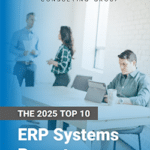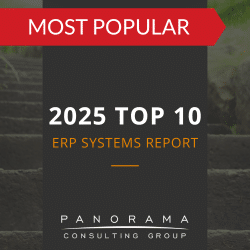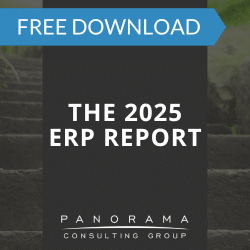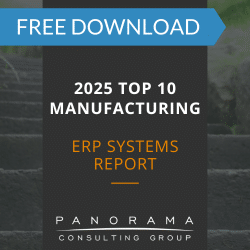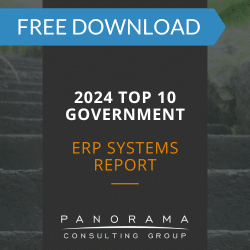- Managing ERP configuration complexity is increasingly tied to digital transformation success at the executive level.
- Configurable ERP system limitations often function as strategic boundaries that protect long-term scalability.
- Configuration complexity frequently stems from misaligned processes, unclear ownership, and internal decision-making gaps.
- Effective ERP configuration is shaped by governance, cross-functional clarity, and alignment with enterprise data standards.
Whether you’re overseeing a supply chain across three continents or scaling operations into new markets, your business architecture is in flux—and your ERP should be able to evolve with it. But with that flexibility comes complexity: configurations that slow down processes, create conflicting workflows, and confuse end-users.
As CEO, your role is to look past the technical details and focus on how each technical decision shapes the business. That’s especially important during ERP configuration, where seemingly small system choices can hardwire inefficiencies.
But here’s the good news: ERP configuration complexity doesn’t have to derail your digital transformation. Let’s explore how to manage the complexity without compromising your vision.
2025 Clash of the Titans
SAP, Oracle, Microsoft, and Infor each have a variety of systems that can support data-driven decision-making. We surveyed customers of these four vendors to find out what their selection and implementation process was like.
Why Configurable ERP Systems are More Complex Than You Think
With the ability to tailor modules, workflows, and data hierarchies comes the need for restraint, governance, and cross-functional clarity.
This is not unlike our recommendations around ERP customization. While configuration is usually less risky than customization, you still can’t throw caution to the wind.
Here are some reasons why ERP configuration requires a cautious, deliberate approach:
1. ERP Configurability Has Clear Limits—and Pushing Past Them Can Backfire
Many ERP platforms offer hundreds of toggles and parameters, but those options exist within a defined framework. Vendors often draw a hard line between what’s configurable and what requires custom code. Crossing that line brings long-term risks, such as system fragility when business rules or reporting requirements evolve.
Configurable ERP system limitations can be beneficial guardrails. They challenge teams to revisit requirements and ask whether they serve the business or simply reflect habit.
For example, a manufacturing executive might decide to prioritize ERP standardization and suggest scaling back overly specific production planning requirements. This would reduce ERP configuration risks by employing standard planning logic, avoiding excessive parameter overrides, and reducing the need for reconfiguration as production schedules change.
2. Configuration Amplifies Process Confusion
Configuration is not a fix for disorganized operations. If your company hasn’t aligned on how core processes are executed across teams and locations, your ERP solution will reflect that disarray.
The result is a patchwork of exceptions and partial rules that mimic old habits rather than drive operational improvement.
ERP configuration works best when there’s alignment around the core (how your company quotes, fulfills, pays, and reports). Start by defining the “enterprise version” of each major process—then configure the ERP system to support that standard.
3. Heavily Configured Systems Are Challenging to Support
Each unique rule, condition, or field you add must be supported, maintained, and tested for the life of the system. When those choices accumulate without oversight, they can complicate training and testing.
Even well-documented configurations create more work for QA teams and super users.
For example, an overly complex order management workflow might require region-specific approvals, conditional pricing rules, and multiple integration points—making testing a burden during every release cycle.
Our ERP selection consultants always advise clients that strong project governance is key to minimizing complex builds and ensuring the system remains easy to maintain, upgrade, and scale over time.
4. ERP Configuration Can Reveal Strategic Indecision at the Top
When executives aren’t aligned on key business decisions before the project starts, configuration ends up filling the gaps—forcing the system to compensate for unresolved leadership debates.
- Who owns the process?
- What qualifies as a global standard versus a regional exception?
- Are we building toward integration or preserving independence across business units?
Without clarity around those decisions, configuration becomes a tool for avoidance. Teams layer on multiple approval paths to appease different executives and preserve legacy processes because no one is willing to challenge the status quo.
Executives should resolve strategic questions early by giving project teams a clear mandate for how the system should support the business moving forward.
How CEOs Can Lead ERP Configuration Without Getting Lost in the Details
You don’t need to understand every toggle or parameter. What you do need is a strategy that filters complexity through the lens of business value.
Here are four leadership strategies that make the complexity of configuration both manageable and mission-aligned.
1. Sponsor a Clear Configuration Governance Model
Configuration can quickly spiral if no one owns the decision-making process.
Governance creates structure around what’s approved, who decides, and how competing interests are weighed. The most effective CEOs ensure this framework is in place before design begins.
A strong governance model includes defined roles for IT, business unit leaders, finance, and compliance. It also includes a change order process—something lightweight but formal enough to track decisions and rationale.
2. Ensure Visibility Into Configuration Risk
Many configuration problems surface too late—during testing, after go-live, or when the system becomes too cumbersome to change. To avoid this, CEOs need a way to see where the system is becoming overly complex.
This starts with asking the right questions:
- Where is configuration most concentrated?
- Which areas are most fragile when changes occur?
- How much documentation supports these decisions, and who owns that knowledge?
You don’t need to monitor every setting. But you should be able to see where risk is accumulating—and how fast.
3. Ensure Configuration Decisions Support Data Integrity
Every dropdown menu, status code, and field hierarchy in the ERP system affects your data. When configuration decisions are made in silos, the result is fragmented data and inconsistent reporting.
CEOs can avoid this by tying configuration directly to the company’s data standards and information strategy. That means ensuring each configured element has a clear owner who understands how it impacts downstream reporting.
It also means requiring teams to explain how changes affect enterprise-wide analytics—especially when metrics roll up across regions or product lines.
For example, a configuration that helps the sales team operate faster may introduce conflicting logic to financial reporting across divisions. Executives must set clear rules for how core data is structured and used across teams to ensure individual team needs don’t undermine company-wide reporting and transparency.
4. Drive Momentum Without Sacrificing Strategy
ERP configuration takes time, and without direction, it can stall. As CEO, your role is to create momentum while protecting the integrity of the long-term vision.
Our ERP implementation consultants often tell clients to set outcome-based milestones tied to real business improvements. Early phases should aim for high-impact wins that demonstrate progress and build user confidence. Later phases can refine and expand on this.
Learn More About Managing ERP Configuration Complexity
Configurable ERP systems aren’t inherently complicated—they become complicated when left to drift. When executives abdicate configuration to project teams without strategic parameters, complexity multiplies.
The opportunity lies in doing the opposite. With structured governance and a configuration philosophy rooted in business intent, configuration becomes a strategic advantage. Contact our independent ERP consultants to learn more.
